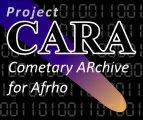



Copyright © All rights reserved. Made By Erik Bryssinck Terms of use | Privacy policy














|
Observation date |
image |
Photometry (FOCAS) |
Afρ |
astrometry |
Observatory |
|
X |
|
|
X |
B96 - |
|
|
X |
|
|
X |
B96 - |
|
|
|
|
|
|
|
|
|
|
|
|
|
|
|
|
|
|
|
|
|
|
|
|
|
|
|
|
|
|
|
|
|
|
|
|
|
|
|
|
|
|
|
|
|
|
|
|
|
|
Comet C/2020 H8 (PANSTARRS)
Photometric data obtained from FOCAS-
COD X02
OBS Telescope.Live Observatory
CATALOG: Gaia DR2 -
10x10 20x20 30x30 40x40 50x50 60x60 SNR SB COD
COMET UTC +/-
-
AFRHO LOG
COMET UTC DELTA r BOX " MAG RSR CM +/-
-
C/2020 J1 Orbital elements not found
FoCAs 3.66
www.astrosurf.com/cometas-
es.groups.yahoo.com/group/Cometas_Obs
Af(rho) data according the CARA-

COMET C/2020 H8 (PANSTARRS)
R. Weryk, Institute for Astronomy, University of Hawaii, reports the discovery by R. Wainscoat of another apparent comet in images obtained with the Pan-
2".5 in 2".1 seeing, with no visible tail, but the cometary appearance was borderline....
.... After the object was posted on the Minor Planet Center's PCCP webpage, other CCD astrometrists commented on the appearance. H. Sato, Tokyo, Japan, writes that fourteen stacked 60-
E. Bryssinck, Kruibeke, Belgium, reported that twenty-
coma") and a hint of a tail of 14" long twoard p.a. 346 degrees; the magnitude was 20.5 in an aperture of radius 5".